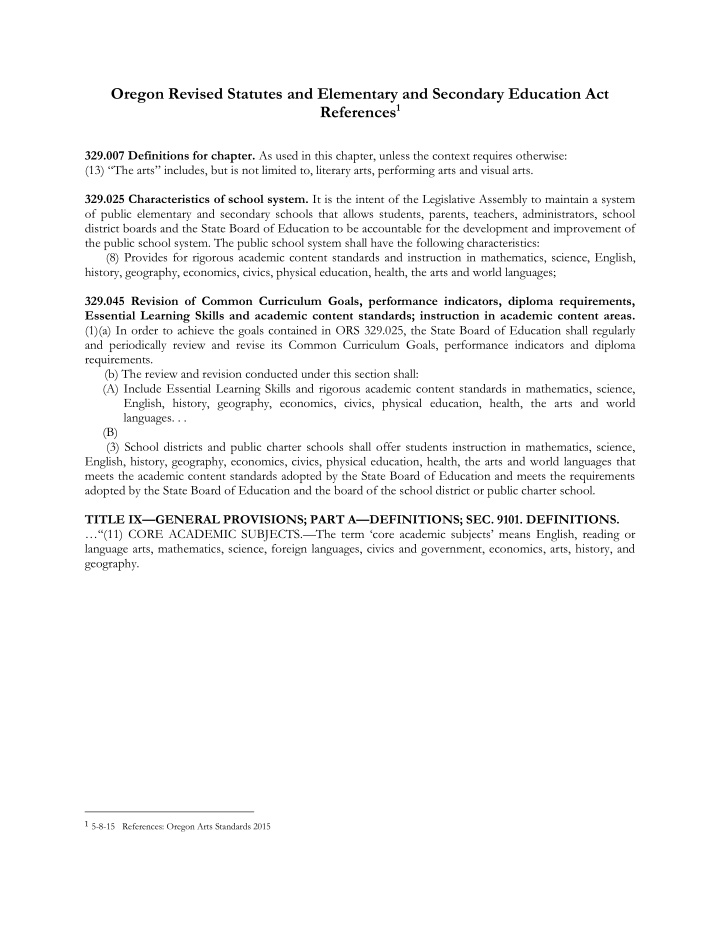



Oregon Revised Statutes and Elementary and Secondary Education Act References 1 329.007 Definitions for chapter. As used in this chapter, unless the context requires otherwise: (13) “The arts” includes, but is not limited to, literary arts, performing arts and visual arts. 329.025 Characteristics of school system. It is the intent of the Legislative Assembly to maintain a system of public elementary and secondary schools that allows students, parents, teachers, administrators, school district boards and the State Board of Education to be accountable for the development and improvement of the public school system. The public school system shall have the following characteristics: (8) Provides for rigorous academic content standards and instruction in mathematics, science, English, history, geography, economics, civics, physical education, health, the arts and world languages; 329.045 Revision of Common Curriculum Goals, performance indicators, diploma requirements, Essential Learning Skills and academic content standards; instruction in academic content areas. (1)(a) In order to achieve the goals contained in ORS 329.025, the State Board of Education shall regularly and periodically review and revise its Common Curriculum Goals, performance indicators and diploma requirements. (b) The review and revision conducted under this section shall: (A) Include Essential Learning Skills and rigorous academic content standards in mathematics, science, English, history, geography, economics, civics, physical education, health, the arts and world languages. . . (B) (3) School districts and public charter schools shall offer students instruction in mathematics, science, English, history, geography, economics, civics, physical education, health, the arts and world languages that meets the academic content standards adopted by the State Board of Education and meets the requirements adopted by the State Board of Education and the board of the school district or public charter school. TITLE IX — GENERAL PROVISIONS; PART A — DEFINITIONS; SEC. 9101. DEFINITIONS. …‘‘(11) CORE ACADEMIC SUBJECTS.—The term ‘core academic subjects’ means English, reading or language arts, mathematics, science, foreign languages, civics and government, economics, arts, history, and geography. 1 5-8-15 References: Oregon Arts Standards 2015
2015 Core Arts Standards and Common Core Criteria Alignment 2 The 2015 Core Arts Standards and Common Core Criteria both include: high-level cognitive demands, demonstrating deep conceptual understanding plus the application of content knowledge and skills to new situations clear sufficient guidance so standards are teachable, learnable, measurable provide guidance for designing of curricula and instructional materials, reasonable in scope, instructionally manageable, promote deep understanding observable, verifiable and measurable learning regarding student attainment of standards student attainment of standards provide a unified vision of big ideas of concepts and reflect a progression of learning limited repetition grade by grade to align instruction to standards high-performing standards to prepare for success in a global economy and society reasonable in scope in defining knowledge and skills students should have ready to succeed in academic college work and workforce training 2 4-28-15 Oregon Arts Standards 2015
2015 Oregon Arts Standards Framework 3 The 2015 Dance, Media Arts, Theatre and Visual Arts Standards were built within a specific framework. This framework provided the structure to address artistic process and literacy learning, and proficiency-based learning of Oregon students preK-12. ARTISTIC PROCESSES: Dance, Media Arts, Theatre and Visual Arts address cognitive processes and physical actions by which arts learning and making are realized. There are four processes in arts learning: Creating (Conceiving and developing new artistic ideas and work); Performing/Presenting/Producing (realizing, interpreting/sharing and presenting artistic ideas and work); Responding (Understanding and evaluating how arts convey meaning); and Connecting (relating artistic ideas and work with personal meaning and external context). ANCHOR STANDARDS: Anchor standards are the fundamental skills we want students to have when they graduate from our public schools. They are general enough to allow for the entrepreneurial aspects of being a teaching professional while being rigorous and aligned to what higher education and workplaces expect of graduating students. As with Common Core Standards, Anchor Standards so position the Arts Standards and extend from pre-K to grade 12. Anchor Standards are alike across all arts disciplines and grades, and comprise a total of 11 like Anchors pre- K-12. ENDURING UNDERSTANDINGS; Enduring Understandings are big idea statements summarizing important ideas and core processes central to a subject and have lasting value beyond the classroom. They articulate what students should value about the content area over the course of their lifetime and enable student to make connections to other disciplines beyond the arts. ESSENTIAL QUESTIONS: Essential Questions are not answerable with finality in a brief sentence. Their purpose is to stimulate thought, provoke inquire, spark more through questions. They guide students as they uncover enduring understandings and encourage, hint at, demand transfer beyond the particular topic and should recur over the years to promote conceptual connections and curriculum coherence. STANDARDS: Standards are based on the four artistic processes, providing a sequential approach to art and within a rigorous supportive learning environment, one of the building blocks of quality arts education. They define artistic literacy, placing artistic processes at the front of the work, identify creative practices, conceptual through lines and articulate value and meaning within and across arts disciplines. MODEL CORNERSTONE ASSESSMENTS: Model Cornerstone Assessments are provided through the 2004 Oregon Arts Standards and 2014 National Core Arts Learning Standards. These models illustrate and bring the standards to life by illustrating the demonstrations of desired learning and the criteria by which student performances should be judged. They are curriculum embedded, recur over the grades, establish authentic contexts for performance, assess understanding and transfer via genuine performance, integrate 21 st C skills, engage students in meaningful learning while encouraging best teaching 3 4-28-15 Oregon Arts Standards 2015
Recommend
More recommend